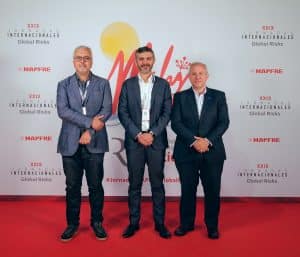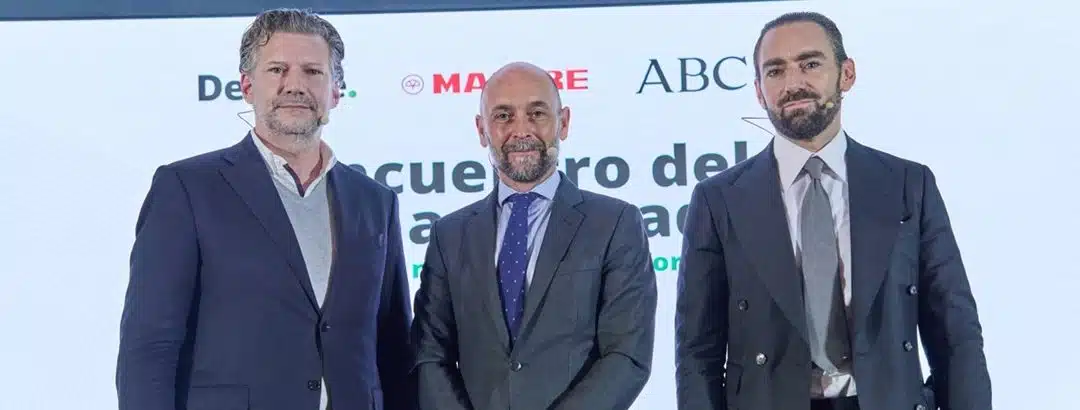Cristina Leon Vera | 12/09/2024
In an increasingly competitive labor market, Global Employee Benefit Programs have become an essential tool for attracting and retaining talent. Flexibility, customization, and coordinated global management are key elements in this regard.
Companies strive to meet the needs of a diverse and ever-changing workforce while ensuring employee productivity and happiness. To achieve this, they offer benefits such as health, life, accident, or pension insurance, which are collectively known as “corporate social protection.” These types of company-managed insurance benefit employees and their families. Additionally, health and wellness programs enhance the employees’ well-being and health, which in turn influences the insured risk.
Fernando Gómez, Deputy Director of Business Development and Head of Global Employee Benefits at MAPFRE Global Risks; Ramón de la Vega, Director of Corporate Risk Financing at Telefónica; and Paulo Rua, Head of Rewards at Galp, shared their wealth of experience during a lively discussion held at the 29th MAPFRE International Global Risks Seminar.
Diversity in Benefits Programs
There are different types of Employee Benefit Programs, with varying levels of complexity. Fernando Gómez explained how coordinated offerings provide information and enable joint negotiation, allowing companies to secure better terms and conditions. Pooling programs balance positive and negative results across different business units, thus contributing to stability and additional capacity. For their part, large companies use captive companies to spread risks and improve their credit rating, managing certain risks internally rather than transferring them entirely to external insurance companies.
Ramón de la Vega presented the case of Telefónica, a company with approximately 105,000 employees across Spain, France, Germany, the United Kingdom, Brazil and several Latin American countries. Benefits are decided by the local HR areas and are adapted to the needs and entitlements of each region. “In all countries, we have life and health insurance. Additionally, there are other supplements, such as contributions to pension plans or meal vouchers,” noted de la Vega.
Paulo Rua emphasized that although the multinational he represents has around 7,200 employees across more than ten countries, the main challenge lies in the diversity of working conditions and benefits within the group, which encompasses over 50 companies. “There is no single benefit that we offer across all geographies. There is a lot of customization,” he stated. The benefits at Galp include insurance, savings plans, wellness programs, discounts on company services and products, and flexible benefits.
Flexibility in Benefits
Flexibility is essential in Employee Benefit Programs. “Different people at different stages of their lives have different needs,” commented Paulo Rua. This includes allowing team members to choose and tailor their benefits according to their personal circumstances. While Galp does not allow switching between benefits, it offers a global matrix designed to be as equitable as possible, enabling employees to convert part of their financial compensation into benefits.
Ramón de la Vega added that, at Telefónica, Brazil has the greatest flexibility in benefits among all countries. Employees can convert their entitlements into points and use them for different services, such as gym memberships, training, or improving their health plan. In Spain, there is also a flexible compensation plan that enables employees to allocate a portion of their salary toward training, purchasing a car, or other goods and services. This system offers tax advantages by reducing the taxable salary by up to 25%, resulting in a positive impact on staff taxation.
Global benefits management
The culture, health system, social security, and insurance market customs influence the benefits in each country. Multinationals often organize these programs with specific objectives, supported by consultants or brokers, and a captive entity is often involved, especially in larger programs.
 Fernando Gómez emphasized the importance of global coordination in benefits programs. Although social compensations may be local, a global structure provides stability in premiums and coverage. For instance, Telefónica uses its captive reinsurance company for life insurance programs in Latin America, thereby maintaining stable coverage and premiums even during crises like the COVID-19 pandemic. “If you can implement a layer of global management, you always gain benefits,” affirmed the Director of Corporate Risk Financing at Telefónica.
Fernando Gómez emphasized the importance of global coordination in benefits programs. Although social compensations may be local, a global structure provides stability in premiums and coverage. For instance, Telefónica uses its captive reinsurance company for life insurance programs in Latin America, thereby maintaining stable coverage and premiums even during crises like the COVID-19 pandemic. “If you can implement a layer of global management, you always gain benefits,” affirmed the Director of Corporate Risk Financing at Telefónica.
At Galp, there is no global program in place, but the focus is on understanding the specific needs of each region. Paulo Rua emphasized that “it’s crucial to customize benefits according to employees’ age, function and role within the company.” The company has made significant investments in senior management benefits, such as company shares, which has boosted retention and alignment with the business strategy.
Adapting to generational changes
Generational changes driven by new expectations and an increasingly digital environment are transforming the employee benefits insurance sector. “In recruitment processes, young candidates place a lot of emphasis on hybrid work and flexibility,” explained de la Vega. “Even team members who aren’t as young greatly value flexibility and hybrid work, as it enables them to better balance their personal and professional lives,” noted Telefónica’s Director of Corporate Risk Financing.
 Paulo Rua pointed out that these changes have implications across different dimensions, from mobility to new ways of working. “The most fundamental aspect is flexibility,” said Galp’s Head of Reward. This includes options such as hybrid work, a four-day workweek and adapting workspaces to meet the needs of team members.
Paulo Rua pointed out that these changes have implications across different dimensions, from mobility to new ways of working. “The most fundamental aspect is flexibility,” said Galp’s Head of Reward. This includes options such as hybrid work, a four-day workweek and adapting workspaces to meet the needs of team members.
Additionally, companies must address issues like mental health. “We are in a period where financial stability for families is increasingly strained. Student loans are now crucial for employees’ education and development,” said Paulo Rua. The ongoing societal shifts are significantly impacting employee benefit insurance, especially on the international front, requiring constant adaptation to emerging realities.
If you want to experience the talk just as it was given in Málaga, watch the video of GEB’s presentation.





